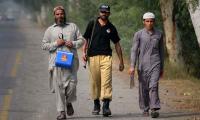This year will mark the 71st year of Pakistan’s independence. It would be correct to say that most Pakistanis today are better off than the Indian subjects of the British Empire. It will also be correct to say that there are exceptions to this norm, and one such exception are the people of Fata. These Pakistanis have been denied their basic rights through the draconian FCR, and have been subjected to collective punishments and discriminatory treatments that should be unthinkable in this day and age.
The beginning of military operations in Fata brought with it grievances against the military. And as is the norm in Pakistan, most political parties and the media shy away from issues where they have to criticise actions taken by Pakistan’s military.
It is in the backdrop of these constraints, and the resulting desperation, that the recent Pashtun dharna in Islamabad can be understood. At the core of this dharna was a group of millennials from the Mehsud tribe of South Waziristan Agency (SWA). Born in the mid-90s the members of this group, Mehsud Tahafuz Movement (MTM), have had a life that is typical for their generation across Fata and parts of Khyber Pakhtunkhwa, all thanks to our policy of good and bad Taliban.
From the massacre of tribal elders across Fata, to the Taliban’s takeover of Fata, to becoming IDPs due to military operations and then returning back to their villages to face landmines, random curfews, and humiliation at checkpoints etc. To understand the desperation of this lot, one only has to imagine one’s own childhood, teenage and young adulthood in their shoes.
Their desperation was further augmented by the indifference to their plight from most of Pakistan’s political parties as well as the media. An indifference that denied them the much-needed public mobilisation that is essential for bringing change. To by-pass this indifference, the MTM did what any group of millennials would do these days; they turned to social media.
The success of their strategy was evident in the size of the crowd at the Pashtun dharna, which kept increasing on a daily basis. A ‘virtuous cycle’ of sorts was created where videos of speeches and charged crowds encouraged participation, which resulted in more galvanizing visuals and motivating speeches, all of which were instantly circulated through social media mostly under the hashtag #PashtunLongMarch. Such was the outreach that the dharna had participants coming from as far as Shangla in the north to Zhob in the south.
The outpouring of sympathy might also be because of the shock factor created by the MTM’s demands; these demands reflect the abysmal manner in which these Pakistanis have been treated by the Pakistani state. For instance, consider their demand that landmines – which have resulted in death and injury – be removed from areas that have been declared ‘clear’ by our military. Similarly, information on the status of missing relatives is not something that citizens should be demanding from the state, as the state should not be creating missing citizens in the first place.
Surprisingly, despite these genuine grievances, the MTM was not able to transcend the ethnic divides within Pakistan, as very few non-Pashtuns participated in the dharna in Islamabad. However, the movement was able to reach out across the tribal and geographical divides within Pashtuns, a significant achievement as tribal identities have been a traditional hindrance for Pashtun nationalist parties.
The main reason for this could be the shared sense of frustration on these issues across Pakistan’s Pashtuns, but the MTM’s measured use of symbolism might also have played its part. For instance, the leader of the MTM, Manzoor Ahmed, uses the name Manzoor ‘Pashteen’ (pronunciation of the word ‘Pashtun’ in Waziristani dialect) instead of using his tribe’s name. Also, during the dharna, the MTM announced it would change its name from the ‘Mehsud Tahafuz Movement’ to the ‘Pashtun Tahafuz Movement’ (PTM). Furthermore, the stage of the Pashtun dharna was open to all, and speakers included relatives of missing persons and terror victims as well as other concerned individuals from across Pakistan, and not just South Waziristan. As a result, the Pashtun dharna resonated across tribes and regions – resulting in solidarity dharnas/protests in Quetta, Bannu, Zhob, Peshawar and Swat.
The effort seems to be bearing fruit already; many missing persons have returned home, and there are reports of bomb disposal teams working on the removal of landmines in Waziristan. The recent abolition of the humiliating ‘Watan Card’ in Waziristan can also be accredited to the efforts initiated by the PTM. These developments are good but there still is a long way to go in terms of the state’s response to address its biases, mistakes and incompetence in dealing with Fata. The PTM has also vowed to continue its struggle until the demands are met in a sufficient manner.
More importantly, the dharna has inspired others to protest about issues in their own regions; in D I Khan, protesters are demanding a clamp down on Amn-committees/Good Taliban who are harassing the local population. Similarly, in Swat, protesters are demanding the removal of military checkpoints after a sick child, on the way to the hospital, died in the waiting line of a military checkpoint. However, in the case of Swat there has been the typical kneejerk response where an FIR has been registered against peaceful protesters. It is this sort of response that is likely to add more fuel to the fire, where legitimate demands are made controversial by simply declaring them ‘anti-state’.
The leader of the PTM, Manzoor Pashteen, responded to such reductionist thinking by saying that: “Yes, we do want “azadi” (independence), the azadi that is enjoyed by the rest of Pakistan”. Labelling genuine grievances as ‘anti-state’ has never worked for us; the fall of Dhaka is testament to that fact. Let’s hope we learn from our history for once, and not repeat the same mistakes again.
The writer is a freelance contributor.
He blogs at iopyne.wordpress.com
Twitter: @iopyne Email: iopyne@gmail.com
To maintain its competitiveness and ensure long-term viability, industry must embrace energy-efficient production...
Judgment which upheld dissolution of Constituent Assembly was blow to democracy and invitation to authoritarianism
For decades, Balochistan has been viewed as a security threat rather than political and developmental partner
Consumers are becoming ‘prosumers’ generating their own power and are fundamentally altering traditional...
With global adoption rising sharply, Bitcoin is a calculated risk worth taking for Pakistan’s economic salvation
There is not much doubt that industrialised nations have historically contributed the most to greenhouse gas emissions







